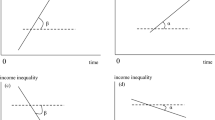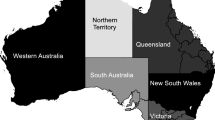Abstract
This paper employs time series methods to analyze convergence across metropolitan and non-metropolitan regions during the 1969–2001 period. The results suggest that non-metropolitan regions are diverging from below the U.S. average income level, while metropolitan regions show mixed evidence of convergence. These summary results vary by geographic location and the size of the region, with medium-sized metropolitan regions showing the strongest tendencies to converge, while non-metropolitan areas with larger urban centers and small towns showed the strongest tendencies to diverge. Differences in human capital (as well as employment concentrations in farming and mining) appear to have influenced the relative performance of metropolitan and non-metropolitan regions during the last 30 years, suggesting a role for agglomeration economies in the observed trend toward divergence.
Similar content being viewed by others
Notes
The estimation does not separately identify RPCPIe and υ 0. Thus, it is possible for υ0 to be large and opposite in sign from RPCPIe, as CM note, and thus for estimates of α and β to be of the same sign even though the series exhibits conditional β-convergence.
This research abstracts from the issue of the relative contribution of each income source to convergence. Hammond and Thompson (2002) show that these contributions may differ. Further, the BEA income data abstracts from considerations of cost of living. It is common in the literature for the U.S. to use data unadjusted for regional costs of living, because these costs are notoriously difficult to measure. However, as Deller et al. (1996), among others, argue, cost-of-living differences may influence the results.
There are 52 commuting zones that are defined as metropolitan in 1990 but were not so defined in 1969. Classifying these new metropolitan zones as non-metropolitan does not alter the qualitative results or their interpretation. Details are available from the author.
The asymptotic standard error, from Campbell and Mankiw (1989), is computed as \(\frac{{{\text{VR}}(5) = 1}}{{{\sqrt {\frac{3}{4}{\left[ {\frac{T}{{N + 1}}} \right]}} }}},\) with 33 observations available, the standard error is 0.49.
Results from Carlino and Mills (1993) for the 1929–1990 period using BEA state regions, and after accounting for a break in 1946, range from 0.22–0.00 for the 5-year impulse response and from 1.09–0.31 for the variance ratio. Results from Carlino and Mills (1996) using U.S. states, and after accounting for a break in 1946, range from 0.7–0.0 for the 5-year impulse response and from 1.72–0.29 for the variance ratio.
I summarize the results here. Full details are available from the author.
Census regions are multi-state aggregates. Commuting zones are assigned to Census regions based on the location of the largest place within the zone.
Small Metropolitan Center: population of the largest MSA in the commuting zone was less than 250,000 in 1990. Medium Metropolitan Center: population of the largest MSA in the commuting zone was at least than 250,000 but less than 1,000,000 in 1990. Major Metropolitan Center: population of the largest MSA in the commuting zone was 1,000,000 or greater in 1990 or the commuting zone is part of a CMSA. Small Town/Rural: population of the largest place in the commuting zone was less than 5,000 in 1990. Small Urban Center: population of the largest place in the commuting zone was at least 5,000 but less than 20,000 in 1990. Larger Urban Center: population of the largest place in the commuting zone was at least 20,000 in 1990.
In contrast, Lall and Yilmaz (2001) present conditional β-convergence results suggesting that, after controlling for spatial spillovers, educational attainment no longer has a significant impact on U.S. state growth. They do find evidence that the educational attainment of first-order-contiguous states has a positive impact on state growth, probably through cross-state commuting relationships.
This will not eliminate possible endogeneity problems, however. As an anonymous reviewer pointed out, industrial structure and levels of educational attainment may have been previously influenced by income levels. Crihfield and Panggabean (1995) find that educational attainment positively influences metropolitan income growth even after significant econometric attempts to control for endogeneity.
References
Barro, RJ (1991) Economic growth in a cross section of countries. Q J Econ 106:407–443
Beeson P, DeJong DN, Troesken W (2001) Population growth in U.S. counties 1840–1990. Reg Sci Urban Econ 31:669–699
Ben-David D, Lumsdaine RL, Papell DH (2003) Unit roots, postwar slowdowns and long-run growth: evidence from two structural breaks. Empir Econ 28:303–319
Campbell JY, Mankiw NG (1989) International evidence on the persistence of economic fluctuations. J Monet Econ 23:319–333
Carlino GA, Mills LO (1993) Are U.S. regional incomes converging? A time series analysis. J Monet Econ 32:335–346
Carlino GA, Mills LO (1996) Convergence and the U.S. states: a time series analysis. J Reg Sci 36:597–616
Crihfield JB, Panggabean MPH (1995) Growth and convergence in U.S. cities. J Urban Econ 38:138–165
Deller SC, Shields M, Tomberlin D (1996) Price differentials and trends in state income levels: a research note. The Review of Regional Studies 26:99–113
Dickey DA, Fuller WA (1981) Likelihood ration statistics for autoregressive time series with a unit root. Econometrica 49:1057–1072
Fuller W (1976) Introduction to statistical time series. New York, Wiley
Garnick DH (1984) Shifting balances in U.S. metropolitan and nonmetropolitan area growth. Int Reg Sci Rev 9:257–273
Glaeser EL, Kallal HD, Scheinkman JA, Shleifer A (1992) Growth in cities. J Polit Econ 100:1126–1152
Hammond GW (2003) Metropolitan/non-metropolitan divergence: a spatial Markov chain approach. Pap Reg Sci 83:543–563
Hammond GW, Thompson E (2001) Convergence and mobility: personal income trends in U.S. metropolitan and non-metropolitan region, BBER Working Paper BBERWP-2003-1, West Virginia University, Bureau of Business and Economic Research, November 2001 (forthcoming International Regional Science Review)
Hammond GW, Thompson E (2002) Mobility and modality trends in U.S. state personal income. Reg Stud 36(4):375–387
Henry MS (1993) The rural economic gap: fact or fiction? in Economic Adaptation: Alternatives for Nonmetropolitan Areas, edited by D.L. Barkley. Boulder, Colorado: Westview, 9–28
Kane R (2001) Investigating convergence of the U.S. regions: a time-series analysis. J Reg Anal Policy 31(1):1–22
Lall SV, Yilmaz S (2001) Regional economic convergence: do policy instruments make a difference? Ann Reg Sci 35:153–166
Mankiw NG, Romer D, Weil DN (1992) A contribution to the empirics of economic growth. Q J Econ 107:407–437
Nissan E, Carter G (1999) Spatial and temporal metropolitan and nonmetropolitan trends in income inequality. Growth Change 30:407–429
Perron, P (1989) The great crash, the oil price shock, and the unit root hypothesis. Econometrica 57:1361–1401
Perron P (1997) Further evidence on breaking trend functions in macroeconomic variables. J Econom 80:335–385
Redman JM, Rowley TD, Angle J (1992) The role of nonmetropolitan economic performance in rising per capita income differences among the states. The Review of Regional Studies 22:155–168
Rupasingha A, Goetz SJ, Freshwater D (2002) Social and institutional factors as determinants of economic growth: evidence from the United States counties. Pap Reg Sci 81:139–155
Tolbert CM, Sizer M (1996) U.S. commuting zones and labor market areas: a 1990 update, ERS Staff Paper # 9614, Economic Research Service, Rural Economy Division
U.S. Department of Commerce (1972) County and city data book, 1972 statistical abstract supplement. U.S. Census Bureau, Social and Economic Statistics Administration, Washington, D.C
U.S. Department of Commerce (2000) Regional economic information service CD-ROM, U.S. Bureau of Economic Analysis,Washington, D.C
Author information
Authors and Affiliations
Corresponding author
Rights and permissions
About this article
Cite this article
Hammond, G.W. A time series analysis of U.S. metropolitan and non-metropolitan income divergence. Ann Reg Sci 40, 81–94 (2006). https://doi.org/10.1007/s00168-005-0029-3
Received:
Accepted:
Published:
Issue Date:
DOI: https://doi.org/10.1007/s00168-005-0029-3




